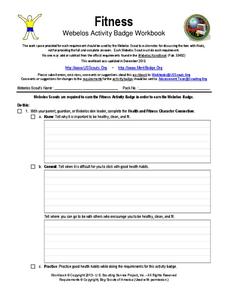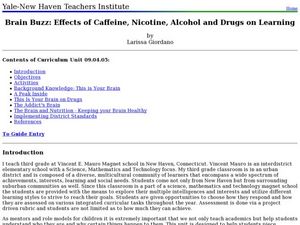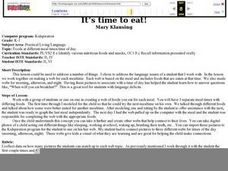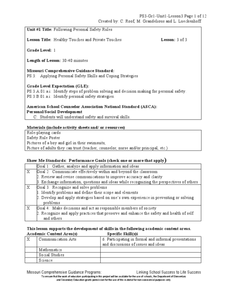Health Smart Virginia
Wrinkled Heart
Contrary to the old saying, words, like sticks, can hurt. That's the central idea in a lesson about the importance of considering another person's perspective, stopping, thinking, and listening before responding in anger to a conflict....
Health Smart Virginia
Compliment a Character
Compliments are true, specific, and positive. Crafting those compliments can be a challenge. Graciously accepting a compliment can also be a challenge. The first lesson in the Health Smart series designed for sixth graders provides them...
Nemours KidsHealth
Concussions: Grades 3-5
Two lessons focus on concussions. The first instructional activity uses cards and role-playing to detail signs of a concussion. Through readings, discussions, and worksheets, the second instructional activity looks closely at parts of...
Health Smart Virginia
Circle of Control with a Kiss
A presentation walks scholars through an exercise of self-control. Using Hershey Kisses, learners listen closely and follow directions, leading them to a worksheet that looks at what they can and can't control. Pupils discuss their...
Nemours KidsHealth
Colds and Flu: Grades K-2
Two lessons identify three steps to prevent catching a common cold or the flu. The first instructional activity turns a familiar song into a friendly reminder to wash hands, cover your coughs, sneezes, and keep hands off your face....
Nemours KidsHealth
Drugs: Grades 3-5
Two lessons take a close look at drug prevention. The first lesson, split into two sessions, challenges learners to gather information from an article, answer questions, then create a poster that encourages others to stay away from...
Purdue University
Well-Being: Dimensions of Wellness
A unit on well-being begins with participants completing a self-assessment worksheet. After reflecting on the results, individuals set well-being goals for themselves that are SMART (Specific, Measurable, Attainable, Relevant, and...
Curated OER
Fitness
In this fitness worksheet, students explain why it is important to be healthy, clean, and fit. In addition, they keep a record of their daily meals and snacks for a week and describe what meals are best for them and why. Finally,...
Curated OER
Body Image
Fifth graders look at advertisements paying close attention to the people in them, then create an advertisement based on a healthy body image. In this health instructional activity, 5th graders analyze magazine or television...
Curated OER
The Case of the Classroom Cleanup
Students complete activities to learn about germs in their classroom and healthy habits. For this germs and health lesson, students participate in a classroom cleanup activity. Students draw germs on a poster of the classroom and...
Curated OER
Arthropods at Home: Spider, Isopod, or any Arthropod
Second graders observe, discuss, and record the requirements of a healthy environment for both arthropods and people by designing and maintaining an artificial habitat for an arthropod, and considering the requirements for a healthy body...
Curated OER
Health Wheel Self-Care Plan For Diabetics
Students create a health wheel outlining an integrated daily living plan for people with diabetes. Using various resources and experiments, students a personalized system for maintaining a healthy lifestyle as a diabetic, including...
Curated OER
Prenatal Development
Students study the stages of prenatal development using a booklet, replicas of the fetus at different developmental stages, and a flip chart. They explain the human reproductive process, infertility, pregnancy, and steps that lead to a...
Curated OER
Brain Buzz: Effects of Caffeine, Nicotine, Alcohol and Drugs on Learning
Students understand how the brain functions and how they can promote a healthy lifestyle. In this health lesson students complete several activities including investigating how stimulates affect the brain.
Curated OER
The Challenge to Deliver Insulin
Students study the types of diabetes and why insulin is important. For this diabetes lesson students build molecular models and create a healthy lifestyle plan.
Curated OER
4-H Performing Arts/Recreation Activity Page
Physical exercise is the focus in this 4-H experience. Students engage in a series of activities involving taking a hike.
Curated OER
Staying Healthy
In this kids' health worksheet, students examine 4 pictures of children practicing good health habits and complete the 4 sentences that accompany each of the pictures.
Curated OER
It's Time To Eat!
Young scholars explore the various types of nutritious foods that can be eaten at meal and snack times. they discuss the types of food they eat at mealtimes. Students use Kidspiration to create a web for each mealtime and each snack.
Montana Office of Public Instruction
Eat Smart Be Smart
Get children's blood pumping with this primary grade lesson on the human heart. After learning about the important role this muscle plays in the human body, students monitor their heart rates and discover the importance of staying active.
Curated OER
Healthy Touches and Private Touches
First graders listen and share ideas. They role play situations where they would use the safety rules and share different kinds of touches that make them feel comfortable, uncomfortable or confused. They discuss what a person can do when...
Curated OER
4th Grade Food Safety Lesson
From a high-speed hand-washing lesson to identifying important nutrients in fruits and veggies, this resource has several activity ideas and worksheets for teaching food safety to your learners.
Curated OER
The Human Body
Explore the human body through hands-on activities. Young learners will trace their bodies and place cut out body organs in the proper place, print patterns using cut fruit, sing songs about good nutrition, and use their five senses...
Curated OER
Human Body Series: Sleep
In this recognizing healthy sleep habits learning exercise, students identify the sleep habits that are healthy and not healthy. Students complete nine answers.
Curated OER
Does Your Diet Stack Up?
Students investigate the food pyramid. In this nutrition lesson, students review the food pyramid and construct a list of what they eat. Students review the nutritional value of their food list and brainstorm ways to improve their diet.

























